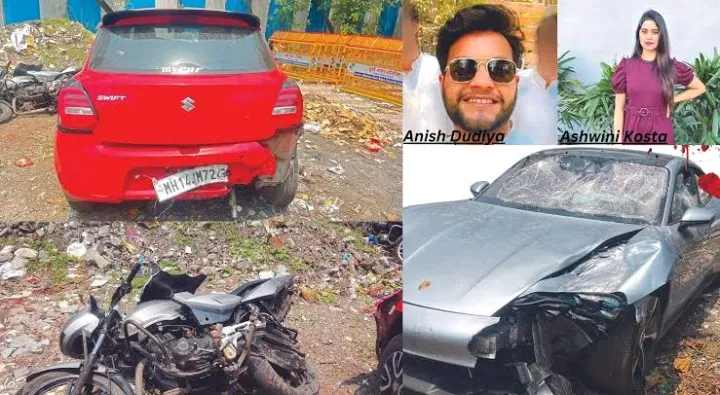Two Lives Lost Underage Crime and Legal Loopholes: The Vedant Agarwal Case Study
The case of Vedant Agarwal, a 17-year-old from Pune, has sparked considerable outrage and debate about the fairness and efficacy of the judicial system in handling cases involving juveniles. On the day of the incident, Vedant, driving at 160 km/h without a license, struck a motorcycle, resulting in the deaths of Aneesh and Ashwani Costa, both 24 years old. Despite the tragic loss of life, the court's decision to impose a relatively lenient punishment on Vedant has raised significant concerns.
Incident Overview
Vedant Agarwal, son of Vishal Agarwal, a prominent builder, was reportedly driving a car without a license at an excessively high speed. He hit a motorcycle carrying Aneesh, an IT engineer from UP, and Ashwani Costa from Madhya Pradesh. Ashwani died instantly, while Aneesh succumbed to his injuries en route to the hospital. Despite the severity of the incident, Vedant received what many consider a lenient punishment: writing a 300-word poem on traffic rules, undergoing counseling, and working with the traffic police for 15 days.
Public Reaction and Judicial Response
The leniency of the punishment given to Vedant has sparked widespread outrage. Many argue that the punishment does not match the severity of the crime, especially considering that the act involved multiple legal violations: underage driving, driving without a license, and reckless driving resulting in fatalities. The initial reaction from the public was one of disbelief and anger, amplified by allegations that the police attempted to shield Vedant from accountability by tampering with evidence, including offering him food to mask any signs of intoxication.
Role of Social Media and Subsequent Actions
Social media played a crucial role in keeping the issue in the public eye and pressuring authorities to take further action. Due to the public outcry, the case saw new developments. Vishal Agarwal, Vedant's father, was arrested, and the pub that served alcohol to Vedant was sealed, with the owner taken into custody. These actions were seen as necessary steps to hold those indirectly responsible accountable and to signal that enabling such behavior would not be tolerated.
Criticism of the Judicial Decision
Critics argue that the court's decision fails to deliver justice for the victims and their families. They point out that Vedant’s actions were not accidents but gross negligence and reckless endangerment that led to the loss of two lives. The lenient punishment undermines the severity of the crime and fails to serve as a deterrent for future offenses. There is a call for the judiciary to recognize the gravity of such incidents and to impose stricter penalties that reflect the seriousness of the crime.
Juvenile Justice and Legal Reforms
This case has reignited the debate over juvenile justice in India. While the law aims to protect minors, there is a growing consensus that individuals who engage in adult-like criminal activities should face proportionate consequences. The leniency shown to Vedant raises questions about whether the current juvenile justice system adequately addresses the complexity of such cases. There is a pressing need for legal reforms that balance the protection of juvenile rights with the necessity of ensuring justice for victims and maintaining public safety.
Conclusion
The Vedant Agarwal case underscores the importance of impartiality and strict enforcement of the law, regardless of the perpetrator's background. It highlights the need for the judiciary to act as a pillar of justice, delivering verdicts that reinforce public trust and deter criminal behavior. The public outcry and subsequent legal actions demonstrate the power of social media in holding authorities accountable and pushing for justice. Moving forward, it is essential for the legal system to address the gaps exposed by this case and ensure that justice is served in a manner that reflects the severity of the crime.
© Pradeep Parmar
Incident Overview
Vedant Agarwal, son of Vishal Agarwal, a prominent builder, was reportedly driving a car without a license at an excessively high speed. He hit a motorcycle carrying Aneesh, an IT engineer from UP, and Ashwani Costa from Madhya Pradesh. Ashwani died instantly, while Aneesh succumbed to his injuries en route to the hospital. Despite the severity of the incident, Vedant received what many consider a lenient punishment: writing a 300-word poem on traffic rules, undergoing counseling, and working with the traffic police for 15 days.
Public Reaction and Judicial Response
The leniency of the punishment given to Vedant has sparked widespread outrage. Many argue that the punishment does not match the severity of the crime, especially considering that the act involved multiple legal violations: underage driving, driving without a license, and reckless driving resulting in fatalities. The initial reaction from the public was one of disbelief and anger, amplified by allegations that the police attempted to shield Vedant from accountability by tampering with evidence, including offering him food to mask any signs of intoxication.
Role of Social Media and Subsequent Actions
Social media played a crucial role in keeping the issue in the public eye and pressuring authorities to take further action. Due to the public outcry, the case saw new developments. Vishal Agarwal, Vedant's father, was arrested, and the pub that served alcohol to Vedant was sealed, with the owner taken into custody. These actions were seen as necessary steps to hold those indirectly responsible accountable and to signal that enabling such behavior would not be tolerated.
Criticism of the Judicial Decision
Critics argue that the court's decision fails to deliver justice for the victims and their families. They point out that Vedant’s actions were not accidents but gross negligence and reckless endangerment that led to the loss of two lives. The lenient punishment undermines the severity of the crime and fails to serve as a deterrent for future offenses. There is a call for the judiciary to recognize the gravity of such incidents and to impose stricter penalties that reflect the seriousness of the crime.
Juvenile Justice and Legal Reforms
This case has reignited the debate over juvenile justice in India. While the law aims to protect minors, there is a growing consensus that individuals who engage in adult-like criminal activities should face proportionate consequences. The leniency shown to Vedant raises questions about whether the current juvenile justice system adequately addresses the complexity of such cases. There is a pressing need for legal reforms that balance the protection of juvenile rights with the necessity of ensuring justice for victims and maintaining public safety.
Conclusion
The Vedant Agarwal case underscores the importance of impartiality and strict enforcement of the law, regardless of the perpetrator's background. It highlights the need for the judiciary to act as a pillar of justice, delivering verdicts that reinforce public trust and deter criminal behavior. The public outcry and subsequent legal actions demonstrate the power of social media in holding authorities accountable and pushing for justice. Moving forward, it is essential for the legal system to address the gaps exposed by this case and ensure that justice is served in a manner that reflects the severity of the crime.
© Pradeep Parmar
Related Stories








